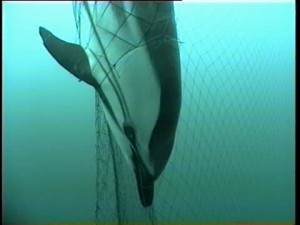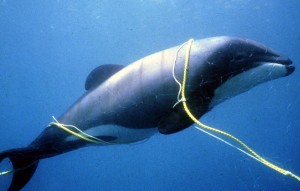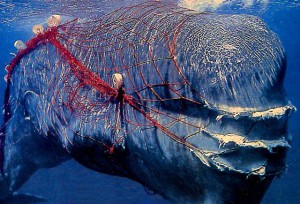Drift Net Fishing
 Considered the most destructive fishing technology ever devised, commercial “drift netting” involves vertically suspending near-transparent nylon nets in ocean waters with floats attached to the top and weights fixed to the bottom. Some are known to be as much as 50 miles wide, with a vertical height of about 50 feet deep.
Considered the most destructive fishing technology ever devised, commercial “drift netting” involves vertically suspending near-transparent nylon nets in ocean waters with floats attached to the top and weights fixed to the bottom. Some are known to be as much as 50 miles wide, with a vertical height of about 50 feet deep.
Once set, the nets are allowed to drift with the wind and currents (hence the term “drift net”) and to snag just about everything in their paths. Drift netting is considered to be the most efficient way to catch large amounts of the ocean’s biggest fish, including tuna, swordfish, marlin and salmon.
Video source: Turtle Island Restorations Network
The problem with these gigantic nets is that they don’t discriminate between fish that can be sold for dinner tables and so-called “by-catch”–marine life not intended for food but which get hauled up anyway and then subsequently discarded dead back into the ocean. Drift netting is responsible not only for killing fish that will never be sold commercially, but also for the unnecessary death of hundreds of thousands of dolphins, seals, whales and sea turtles every year, despite international agreements outlawing the practice.
Driftnets also sometimes break loose, sailing through the oceans unattended, “ghost fishing” until they sink to the bottom under the weight of their victims or wash up onshore where they snag seabirds, seals and other unsuspecting wildlife.
First developed by Japan in the 1970s, drift netting quickly caught on elsewhere and within just a decade scientists began to notice that the practice was taking a severe toll on marine biodiversity.
 Various experiments were conducted that bore out these concerns. A 1989 test using driftnets to catch tuna, for example, killed an average of four and a half marine mammals in every “set”–one whale or dolphin for every 10 tuna caught. Meanwhile, analysts observed a Japanese boat kill 59 dolphins and small whales in just 30 sets–a rate of almost two per set. Multiply this scenario by commercial fishing fleets deploying 30,000 miles of driftnets globally – every single day – during the 1980s!
Various experiments were conducted that bore out these concerns. A 1989 test using driftnets to catch tuna, for example, killed an average of four and a half marine mammals in every “set”–one whale or dolphin for every 10 tuna caught. Meanwhile, analysts observed a Japanese boat kill 59 dolphins and small whales in just 30 sets–a rate of almost two per set. Multiply this scenario by commercial fishing fleets deploying 30,000 miles of driftnets globally – every single day – during the 1980s!
The first major effort to stop drift netting was the Wellington Convention, which was signed in New Zealand in 1989 and put into place a driftnet ban in the South Pacific. Four years later, the United Nations called for an international moratorium on the practice.
Meanwhile, in 1992 Russia, Japan and the United States created the Convention for the Conservation of Anadromous Stocks in the North Pacific, banning all driftnets more than 1 1/2 miles in length (“anadromous” refers to fish like salmon that live in salt water but spawn in fresh water). South Korea signed on but China did not, though it agreed to let the U.S. Coast Guard help police its fleet. In 2002, the European Union banned drift netting by its member countries.
 According to Earthtrust, a U.S. nonprofit committed to ending drift netting, despite such commitments commercial fishing fleets around the world still deploy tens of thousands of miles of driftnets on a daily basis. While efforts to stop the practice have no doubt had some effect, drift netting remains one of the biggest drivers of over-fishing today. As long as demand for tuna, salmon and other big fish continues, drift netting–illegal or otherwise–is likely to continue to wreak havoc on the world’s marine ecosystems.
According to Earthtrust, a U.S. nonprofit committed to ending drift netting, despite such commitments commercial fishing fleets around the world still deploy tens of thousands of miles of driftnets on a daily basis. While efforts to stop the practice have no doubt had some effect, drift netting remains one of the biggest drivers of over-fishing today. As long as demand for tuna, salmon and other big fish continues, drift netting–illegal or otherwise–is likely to continue to wreak havoc on the world’s marine ecosystems.
Learn more
Earthtrust timeline of drift net fishing, 1976 -1995…
The Impact of Driftnet Fishing on Sustainable Fisheries…
International Law Governing Driftnet Fishing on the ‘High Seas’…
Driftnet fisheries and their impacts on non-target species: a worldwide review…